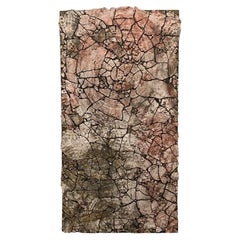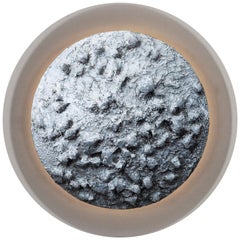Moon Seop Seo Contemporary Art
to
2
2
2
Height
to
Width
to
2
2
2
2
2
2
2
2
2
2
126
67
36
34
Creator: Moon Seop Seo
BITSCAPE - 2 - Contemporary South Korean Ceramic Wall Sculpture by Moon Seop Seo
By Moon Seop Seo
Located in Amsterdam, NL
“I would like my works to spark our imagination and leave exclamation marks on our daily life.”
Moon Seop Seo graduated Design Academy Eindhoven in 2021...
Category
21st Century and Contemporary South Korean Post-Modern Moon Seop Seo Contemporary Art
Materials
Ceramic
$6,242 Sale Price
20% Off
BITSCAPE - 1 - Contemporary South Korean Ceramic Wall Sculpture by Moon Seop Seo
By Moon Seop Seo
Located in Amsterdam, NL
“I would like my works to spark our imagination and leave exclamation marks on our daily life.”
Moon Seop Seo graduated Design Academy Eindhoven in 2021...
Category
21st Century and Contemporary South Korean Post-Modern Moon Seop Seo Contemporary Art
Materials
Ceramic
$5,378 Sale Price
20% Off
Related Items
'Fragile Flower' A Unique Ceramic Wall Sculpture, Pekka Paikkari, 2021
By Pekka Paikkari
Located in Helsinki, FI
An impressive ceramic wall sculpture ”Fragile Flower" made by Pekka Paikkari in 2021. This art piece is in pristine condition and was acquired from the artist himself.
Pekka's prima...
Category
2010s Finnish Modern Moon Seop Seo Contemporary Art
Materials
Ceramic, Wood
$32,655 Sale Price
20% Off
H 72.05 in W 38.19 in D 1.58 in
Mid-Century Modern Moon Wall Art Sculpture Piece, Light, Handmade by Greenapple
By Greenapple
Located in Lisboa, PT
Mid-Century Modern Moon Wall Art Piece, Contemporary Collection, Handcrafted in Portugal - Europe by Greenapple.
The Moon modern wall decor is a manifes...
Category
21st Century and Contemporary Portuguese Mid-Century Modern Moon Seop Seo Contemporary Art
Materials
Acrylic, Resin, Wood
$7,803 / item
H 7.09 in Dm 47.25 in
1987 Brass Metal Swan Wall Sculpture by Curtis Jere
By Curtis Jeré
Located in Staten Island, NY
Brass and Metal Swan Wall Sculpture by Curtis Jere, circa 1987
Sophisticated and well made wall art that will enhance any room.
Category
1980s Post-Modern Vintage Moon Seop Seo Contemporary Art
Materials
Metal, Brass
Neoclassical Contemporary Design Wall Mounted Stone Cherub, Angel Sculpture
Located in Reading, Berkshire
Unusual Decorative neoclassic Revival Putti/Cherub Stone Cast Sculpture With Metallic Wings, Wall Mountable.
Classicism is a specific genre of philosophy, expressing itself in literature, architecture, art, and music, which has Ancient Greek and Roman sources and an emphasis on society. It was particularly expressed in the neoclassicism of the Age of Enlightenment...
Category
21st Century and Contemporary Unknown Neoclassical Revival Moon Seop Seo Contemporary Art
Materials
Cast Stone, Sheet Metal
$1,950 Sale Price
50% Off
H 14.18 in W 20.67 in D 7.88 in
'Brittle Moment' A Unique Ceramic Wall Sculpture, Pekka Paikkari, 2015
By Pekka Paikkari
Located in Helsinki, FI
An impressive ceramic wall sculpture ”Brittle Moment” made by Pekka Paikkari in 2015. Featuring a beautiful and unique design, in which the artists imagination is combined with a cre...
Category
2010s Finnish Modern Moon Seop Seo Contemporary Art
Materials
Ceramic, Wood
$12,293 Sale Price
20% Off
H 45.28 in W 24.81 in D 1.19 in
Joanna Poag Flourish II Wall Ceramic Sculptures, 2015
By Joanna Poag
Located in New York, NY
Contemporary American ceramic artist Joanna Poag's Flourish II Sculptures are hand built and glazed white to give them a lightness and more attention to shadow. Flourish II looks at ...
Category
21st Century and Contemporary American Organic Modern Moon Seop Seo Contemporary Art
Materials
Ceramic
"Eterna" Contemporary Wall Sculpture in Reclaimed Murano Glass by Tommaso Spinzi
Located in Milano, IT
"Eterna" is an arwork concept that celebrates the beauty of art glass, its vivid colours and its upcycling possibilities, that allow for a potentially endless recycling.
Created with...
Category
2010s Italian Modern Moon Seop Seo Contemporary Art
Materials
Murano Glass
$1,075 Sale Price
20% Off
H 1.97 in Dm 23.63 in
Contemporary Design 'Momentum standing wall sculpture" by Andredottir & Bobek
By Andredottir & Bobek
Located in copenhagen, DK
One of a kind, contemporary design, momentum standing wall sculpture embody the surface of lava stone and rocks.
Made by the art and design duo Andredottir & Bobek
They have in t...
Category
2010s Danish Modern Moon Seop Seo Contemporary Art
Materials
Foam
$7,758
H 57.09 in W 12.6 in D 4.73 in
Large Moon Wall Mounted Sculpture by Michel Pichard
By Michel Pichard
Located in Saint-Ouen, FR
White Patina on resin moon wall-mounted sculpture by the French artist Michel Pichard
Edition 4/20
Measures: larger dimensions 150 cm diameter for 20 cm depth.
Category
2010s European Modern Moon Seop Seo Contemporary Art
Materials
Resin, Wood
Contemporary Wall Mounted Sculpture from 'Ripples' Series by James Rowland
By Knót Artesanal
Located in Paraty, Rio de Janeiro
A piece from the 'Ripples' abstract sculpture series by James Rowland made from solid hard wood Sucupira.
Scottish Artist and furniture Designer-Maker J...
Category
2010s Brazilian Modern Moon Seop Seo Contemporary Art
Materials
Wood
$700
H 15.75 in W 7.49 in D 2.37 in
Large Moon Wall Mounted Sculpture by Michel Pichard
By Michel Pichard
Located in Saint-Ouen, FR
Moon wall-mounted sculpture by the French artist Michel Pichard
Edition 4/20
Measures: larger dimensions 150 cm diameter for 20 cm depth.
Category
2010s European Modern Moon Seop Seo Contemporary Art
Materials
Resin, Wood
White with Black Ceramic Wall Sculpture by Yann Masseyeff, France, Contemporary
Located in New York, NY
Contemporary French artist Yann Masseyeff creates a dramatic wall sculpture.
Using ceramic / stoneware spheres of different design in an exposed shadow box made of white wood.
Lighting creates...
Category
21st Century and Contemporary French Moon Seop Seo Contemporary Art
Materials
Plaster
$14,950
H 39 in W 39 in D 2 in
Moon Seop Seo contemporary art for sale on 1stDibs.
Moon Seop Seo contemporary art are available for sale on 1stDibs. These distinctive items are frequently made of ceramic and are designed with extraordinary care. Prices for Moon Seop Seo contemporary art can differ depending upon size, time period and other attributes — on 1stDibs, these items begin at $6,361 and can go as high as $7,332, while a piece like these, on average, fetch $6,847.



